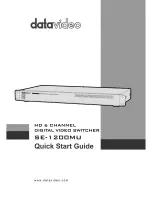
DGS-3312SR Stackable Gigabit Layer 3 Switch
viii
About This Manual
This manual is divided into ten general sections:
Section 1, Introduction
- Describes the Switch’s hardware and its features.
Section 2, Installation
- Helps you get started with the basic installation of the Switch and also describes the front panel,
rear panel, side panels, and LED indicators of the Switch.
Section 3, Basic Management
- Tells how you can connect the Switch to your Ethernet network.
Section 4, Basic Configuration
- A detailed discussion about configuring some of the basic functions of the Switch,
including accessing the Switch information, using the Switch's utilities and setting up network configurations, such as
Quality of Service, The Access Profile Table, port mirroring and configuring the Spanning Tree.
Section 5, Layer 3 IP Networking
- Talks about configuration of the Layer 3 networking functions of the Switch
including RIP, OSPF, VRRP, DVMRP and PIM.
Section 6, Management
- A discussion of the security features of the Switch, including Security IP, User Accounts,
Access Authentication Control, SSH and SSL.
Section 7, Management
– A detailed discussion regarding User Accounts and the Simple Network Monitoring Protocol
including description of features and a brief introduction to SNMP.
Section 8, Monitoring
- Features graphs and screens used in monitoring features and packets on the Switch.
Section 9, Maintenance
- Features information on Switch utility functions, including TFTP Services, Switch History, Ping
Test Save Changes and Rebooting Services.
Section 10, Single IP Management
- Discussion on the Single IP Management function of the Switch, including functions
and features of the Java based user interface and the utilities of the SIM function.
Intended Readers
The DGS-3312SR Manual contains information useful for setup and management and of the DGS-3312SR Switch. This
manual is intended for network managers familiar with network management concepts and terminology.
Typographical Conventions
Convention Description
[ ]
In a command line, square brackets indicate an optional entry. For example: [copy
filename] means that optionally you can type copy followed by the name of the file. Do
not type the brackets.
Bold font
Indicates a button, a toolbar icon, menu, or menu item. For example: Open the
File
menu and choose
Cancel
. Used for emphasis. May also indicate system messages or
prompts appearing on your screen. For example:
You have mail
. Bold font is also
used to represent filenames, program names and commands. For example: use the
copy
command.
Boldface
Typewriter Font
Indicates commands and responses to prompts that must be typed exactly as printed
in the manual.
Initial capital letter
Indicates a window name. Names of keys on the keyboard have initial capitals. For
example: Click Enter.
Italics
Indicates a window name or a field. Also can indicate a variables or parameter that is
replaced with an appropriate word or string. For example: type
filename
means that
you should type the actual filename instead of the word shown in italic.
Menu Name >
Menu Option
Menu Name > Menu Option
indicates the menu structure.
Device > Port > Port
Properties
means the Port Properties menu option under the Port menu option that is
located under the Device menu.










































